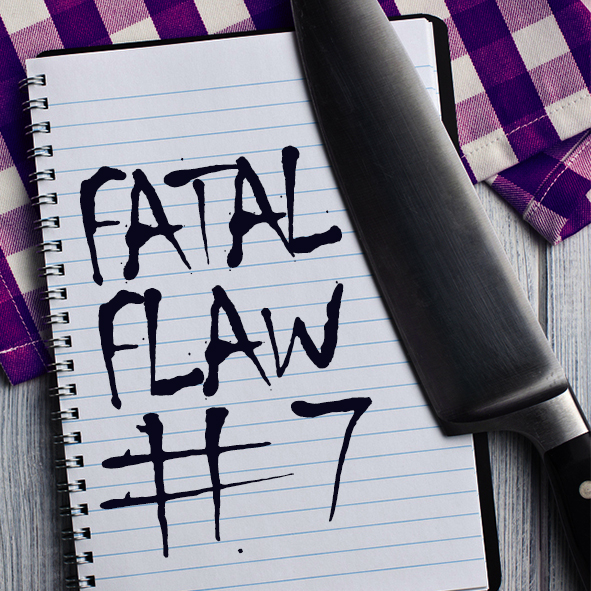How To Write A Perfect Cliff-Hanger
Today’s guest post is by Rachael Cooper.
Fiction thrives on conflict. Whether it’s a bank robbery or a breakup, our best stories tend to be about people striving to achieve something while other people and events get in their way. In stories, conflict drives the plot, and the plot is what keeps readers reading.
Your job as a storyteller is to captivate your reader. A good story should be impossible to put down. You want to get your reader dying to see what happens next.
With so many distractions out there, this can appear impossible, but don’t worry—there are plenty of ways writers grab and hold their reader’s attention.
From well-crafted characters to plot twists to sharp dialogue, there is a selection of skills and techniques you should try to hone in your writing game to keep your reader on the edge of their seat. One of my favorite ways to hook a reader, and keep them hooked, is by using cliff-hangers.
In this post, I’ll be drilling down into the world of cliff-hangers. I’ll discuss the mechanics of cliff-hangers as well as the best ways to use cliff-hangers in your stories. There will also be plenty of examples of cliff-hangers from great writers and stories to help you see their potential. Plus, I’ll share some of the best tips I’ve come across on how to write the perfect cliff-hanger.
What Is a Cliff-hanger?
A cliff-hanger is a plot device in a scene, chapter, or section of the story that ends suddenly without warning or resolution. Remember, a cliff-hanger isn’t supposed to be a long descriptive passage. A cliff-hanger must be abrupt. You want it to be short, sharp, and shocking.
When writing a cliff-hanger, try to use one or two short sentences, three maximum. Take a look at this example from Ian Fleming (creator of James Bond): “And there was only one man in the whole world who could stop it. But how?” Note how he finishes the section in a chapter near the end of Goldfinger with a two-word question.
Often, the character is left in a precarious or dangerous situation. By cutting a scene before the problem is resolved, you are effectively promising a resolution in the near future. Think of it as setting up a joke, and the reader has to turn the page for the punchline. The ultimate goal of a cliff-hanger is to captivate and engross the reader by building tension.
One of the greatest pulp fiction writers of all time, Raymond Chandler, was known for his liberal use of cliff-hangers. One of his favorite techniques for fixing the end of a scene that fizzled out was to finish it with a man walking into the room holding a gun.
While your cliff-hangers don’t have to be quite so literal, your main goal with a cliff-hanger is to get the reader to turn the page. You can accomplish this by taking your reader to a place where they absolutely, positively need to know what happens next.
Resolving Cliff-hangers
Cliff-hangers need resolution. If you don’t resolve a cliff-hanger, it will come across as a plot hole or just plain frustrating as the reader feels tricked. However, you don’t need to resolve the cliff-hanger in the first line of the very next chapter.
Think about drawing out the tension. You can even switch to another scene and come back later to resolve the character in crisis. Stephen King is a master of leaving his characters dangling from a cliff. He filled his sprawling epic The Dome with chapters ending with one character in a life-or-death scenario and the next taking the reader somewhere else in the doomed town.
Try to have your resolution in mind when you’re writing your cliff-hanger. Leaving it until the last minute can be an excellent way to push your imagination, but a far-fetched resolution might expose your unpreparedness.
Try not to rely on deus ex machina to get your character out of a jam. This is where your resolution is so improbable that it seems almost like divine intervention. Readers will see right through it and probably throw your book across the room.
Tips on Coming Up with Cliff-hangers
There are a few exercises, tips, and techniques you can utilize as a writer to get your cliff-hanger ideas flowing. If you’re stuck trying to come up with a tricky situation for your character, try the following tips and see if one of them works.
Practice inventing problems for your characters. A good way to do this is by asking yourself what’s the worst thing that could happen? This doesn’t mean that a cliff-hanger always has to be about life and death. Moral, emotional, and interpersonal problems can be just as dramatic as guns, bombs, and runaway trains.
The key to a cliff-hanger is conflict. A nice and simple way to do this is by asking a rhetorical question (like the Goldfinger example above). A character telling your protagonist some unexpected news is also a good way to inject some spice into your writing.
Many authors use foreshadowing to end their scene on a cliff-hanger. Check out Donna Tartt’s ending to Chapter 2 of The Goldfinch: “I understood the instant I saw them that my life, as I knew it, was over.” You can use a foreshadowing/cliff-hanger combination to build suspense, but it can also be used to introduce your inciting incident.
Here’s another great example of using a cliff-hanger ending that also serves as foreshadowing. This one comes at the end of Chapter 1 of War of the Worlds, by H. G. Wells: “My wife pointed out to me the brightness of the red, green, and yellow signal lights hanging in a framework against the sky. It seemed so safe and tranquil.”
How to Write a Perfect Cliff-hanger
Keeping your readers engaged requires a fine balance of plot, character development, and emotional development. If you’re having trouble ending a scene or your scene fizzles out or falls flat, think about injecting some serious conflict into your character’s life with a killer cliff-hanger.
They are great devices for driving plot and keeping your readers on the edge of their seats. So, take some time to learn the basics, then start using cliff-hangers in your writing. It won’t take long to have your readers dying to know what happens next.
 Rachael Cooper is the SEO & Publishing Manager for Jericho Writers, a writers’ services company based in the UK and US. Rachael has a master’s in eighteenth-century literature and specializes in female sociability. In her free time she writes articles on her favorite eighteenth-century authors and, if all else fails, you can generally find her reading and drinking tea!
Rachael Cooper is the SEO & Publishing Manager for Jericho Writers, a writers’ services company based in the UK and US. Rachael has a master’s in eighteenth-century literature and specializes in female sociability. In her free time she writes articles on her favorite eighteenth-century authors and, if all else fails, you can generally find her reading and drinking tea!









Cliffhangers are the lifeblood of any sort of mystery or action story. I have to acknowledge John Blaine here. His “Rick Brant” books not only provided me with some of my best reading experiences as a child, but taught me the art of the cliffhanger. In a lot of his novels Rick and Scotty get separated, both fighting the baddies and often looking for each other. Then he writes alternate chapters for the two characters, so that through each you are worrying about the other character.
I’ve tried to do this in my own novels. In the first Arthur has captured Jane and wants to interrogate her. He hands her over to Peters with instructions to “Soften her up for interrogation”. Then I cut to a chapter about another character. When I come back instead of Peters hurting Jane, she has demonstrated the art of dirty fighting and Peters has to be taken to hospital.
You may spot the tribute to the scene where Vader takes the torture robot into Leia’s cell here. Try that with Jane and Vader is going to come out in pain while the robot is a burning wreck on the floor.
There is a more intense version in the second book. The way I see it is that a cliffhanger is a scene where two or more outcomes are possible, but the likely one is worst for the protagonist.
I turned the tension up further by getting to a point were Jane has succeeded in the mission, but the spaceship she is in is about to crash into the sun.
Jane twisted the wrist rings of her suit, checking for free movement. ‘It is. We’ve run out of options. The sun’s gravity is pulling us in, the orthodynamic drive is beyond repair.’
‘It can’t be.’
Jane shook her head. ‘If it wasn’t I’d be back there repairing it. And the main engine pipework is ripped apart. We might as well face it—it’s not a question of if we’re going to die, or even when. All that’s left to decide is how. And I intend to hang on to my self-respect to the end, thank you. That’s why I’d prefer it if you didn’t go to pieces.’
I’m trying to get the reader to the point where they realise that even Jane can’t fix this one, and she is coming to accept her own death.
Jane smiled. ‘…But I’ve no regrets. Or just one. I’d hoped that they’d bury me near Alan so that we could be together in the end. My only sadness is that there’ll be nothing for them to bury—Alan’s going to be alone for all time. And I’ll be part of a star that’s barely visible in his sky. Can you hear that?’
There was a faint murmuring, as of mice scuttling around under the deck.
‘Something’s beginning to boil. Probably what’s left of the heat shielding. I’d guess about three minutes now.’
Evil author time. I’m trying to get the reader to think this is curtains. In fact there is a setup further back in the book which is a clue to the trick that Ian, in another ship, uses to push her clear.
I really like cliffhangers, thanks for including them
My favourite thing about cliffhangers? They can be really delicately done – just a dab of paint at the end of the chapter. Or they can be massive – literally a “can they save the world?” kind of moment. I love that kind of flexibility. And that’s where “evil author time” really comes in. If you’ve had a few light touch chapter endings, you can really hit the reader with a big on. Mwah-hah-hah-hah
I love your opening remarks that fiction thrives on conflict, conflict drives the plot, and the plot is what keeps readers reading. This is so important for authors to understand, especially first-time authors. And I am glad you included the section on cliffhanger resolution. Nothing is more frustrating than a cliffhanger that just hangs there, never to be mentioned again. Nice article.
Thanks, Florence!!
Nice!
That quite summed it up, cliffhangers